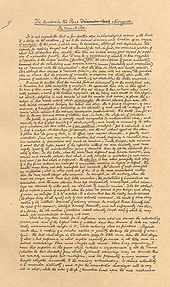Facsimile
A facsimile (from
Facsimiles in the age of mechanical reproduction
Advances in the art of facsimile are closely related to advances in

In the past, techniques and devices such as the philograph (tracing an original through a transparent plane),
A separate category consists of the so-called digital facsimiles, which are meant to be stored, viewed, and sometimes edited or annotated on a computer. These are often available online in repositories that consist of manuscripts from a particular location or collection.[3] Such digital facsimiles are considered separate objects from the manuscripts or books that they represent.[4] They are an important research aid, especially for historians.
Facsimiles and conservation
Important
Facsimiles are best suited to printed or hand-written documents, and not to items such as three-dimensional objects or oil paintings with unique surface texture.[8] Reproductions of those latter objects are often referred to as replicas.
See also
References
- ^ a b C. Koeman, "An Increase in Facsimile Reprints", Imago Mundi, vol. 18 (1964), pp. 87-88.
- ^ Craig Hartley, "Aquatint", The Oxford Companion to Western Art, ed. Hugh Brigstocke. Oxford University Press, 2001; Grove Art Online, Oxford University Press, 2005. [accessed 20 April 2008].
- ^ "e-codices. Virtual Manuscript Library of Switzerland". www.e-codices.unifr.ch. Retrieved 2024-04-12.
- ISSN 2055-7671.
- ^ "Facsimile Editions - Our Books in Public Institutions". www.facsimile-editions.com. Archived from the original on 2017-07-16. Retrieved 2019-05-23.
- ^ Paul Lewis, "Preservation takes rare manuscripts from the public", New York Times - 25 January 1987 [accessed 19 April 2008].
- ^ Bronwyn Stocks, "The Facsimile and the Manuscript", - an exhibition in the Leigh Scott Gallery, University of Melbourne (on-line catalogue with additional images).
- ^ Richard Godfrey, "Reproduction reproductive prints", The Oxford Companion to Western Art, ed. Hugh Brigstocke. Oxford University Press, 2001; Grove Art Online, Oxford University Press, 2005. [accessed 20 April 2008].
